Verdict
The Asus ROG Zephyrus M16 (2023) delivers incredible speed thanks to Nvidia’s latest graphics core. And elsewhere you get a robust, light chassis and one of the best gaming laptop displays ever – but forthcoming rigs will be faster, and in several areas the M16 is too ordinary.
Pros
- Incredible gaming and processing speed
- One of the best laptop screens ever
- Fast, comfortable keyboard
- Sleek, sturdy and light chassis
Cons
- Other laptops will be even faster
- Annoying LEDs in lid
- Better connectivity and ergonomics elsewhere
- Difficult to get inside
Availability
- UKRRP: £4099
- USARRP: $3499
- EuropeRRP: €5099
-
Nvidia’s GeForce RTX 4090The new Nvidia GeForce RTX 4090 laptop graphics core is a barnstorming chip that will scythe through almost any gaming task, although in this laptop it doesn’t run at the peak of its powers. -
A fantastic Mini LED displayThe Mini LED display delivers incredible depth, contrast and nuance – it’s the best gaming laptop screen on the market right now and makes titles look their best. Elsewhere, the 240Hz refresh rate, 16:10 aspect ratio and high resolution all improve visual versatility. -
A sleek, robust chassisThe aluminium case has great build quality and a smart, subtle aesthetic – and it’s lighter than virtually any rival too, including laptops coming later this year.
Introduction
Asus usually pushes the envelope with gaming laptops, and the Asus ROG Zephyrus M16 (2023) shy away from innovation – because it crams an Nvidia GeForce RTX 4090 into a surprisingly small chassis.
That’s not the only surprise you’ll find here. It’s got one of Intel’s beefiest Core i9 processors, and the lid is filled with customisable LEDs.
The design will tempt any gamer, but it will also cost $3499/£4099/€5099. And no matter where you live, that’s a healthy chunk of change.
With the Razer Blade 16 and Alienware m16 R1 arriving soon, and existing laptops like the Asus ROG Flow X16 offering stiff competition, it might be tricky for the M16 to secure a slot on our best gaming laptops 2023 chart.
Design and Keyboard
- The aluminium enclosure is smart, light and robust
- The AniMe Matrix lid is a gimmick that adds weight
- The keyboard and trackpad are fine for everyday use
Asus hasn’t made big changes to the outside – this GU604 model looks similar to the GU603 from 2022. But when the rig uses matte aluminium alloy, black surfaces and sleek lines to craft a stylish chassis that’s not necessarily a problem.
You’ll find speaker grilles on each side of the keyboard, cooling vents below the screen and an ergo hinge that pushes the keyboard upwards to improve typing angles and internal cooling.
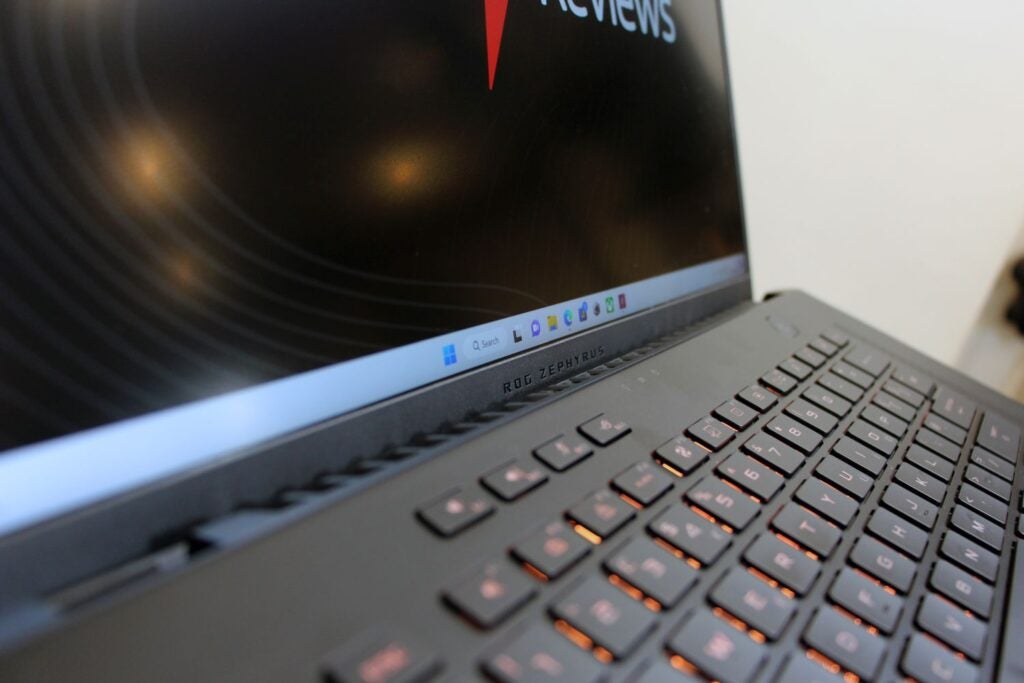
Build quality is impressive, with hardly any give in the panels, and the RTX 4090 version of this laptop weighs 2.3kg and is 22.9mm thick. That compares well to the Razer and Alienware laptops, which will weigh 2.45kg, although the Asus ROG Flow X16 convertible is slimmer and lighter.
The AniMe Matrix lid is the M16’s boldest design feature: it’s got 1,711 LEDs that sit behind 18,710 CNC-milled holes. They’re customisable with animations, text, a virtual pet or information like your battery life and email count. It’s a gimmick, though, and only runs in white – and the LEDs add 200g to the rig’s weight. Thankfully the AniMe Matrix is only available on the RTX 4090 model.
There are other areas where the design falters. The status lights sit beneath the screen and they’re basically impossible to see. And while the Asus has memory slots and SSD connectors for component upgrades, it’s extremely difficult to get inside – it feels like Asus has made it unnecessarily hard.
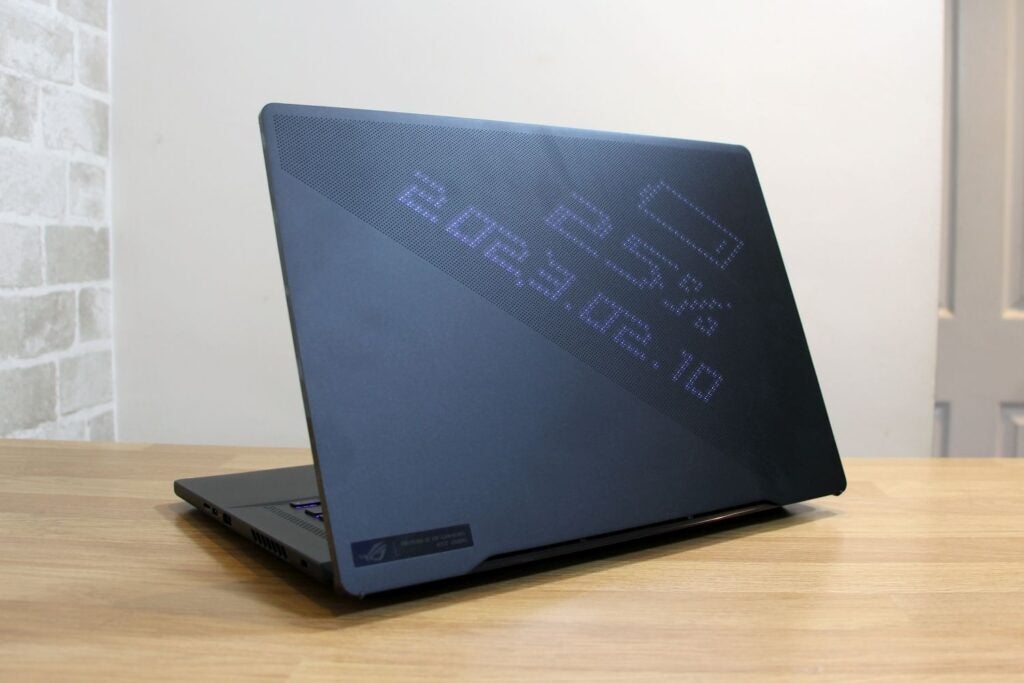
The keyboard is crisp, fast and reliable, so it’s well-suited to fast-paced gaming, but it omits the numberpad and only has single-zone RGB LED lighting. The Alienware is available with mechanical upgrades and the Razer has per-key RGB LEDs. The trackpad is mediocre, too, with soft buttons that won’t sate demanding gamers – use a USB mouse instead.
And while connectivity is fine, other laptops are better. The Asus has two USB 3.2 Gen 2 ports, a USB 3.2 Gen 2 Type-C port and one Thunderbolt connection alongside a microSD slot and HDMI 2.1 output. Internally it’s got Wi-Fi 6E, Bluetooth 5.2 and a 1080p webcam with Windows Hello support.
The Alienware and Razer rigs both have SD card readers and 2.5Gbps Ethernet, the Alienware has two Thunderbolt ports, and the Razer has three full-size USB connectors.
Screen
- Incredible contrast, depth, detail and vibrancy on the Mini LED screen
- The 240Hz refresh rate and solid resolution deliver absorbing visuals
- The speakers are good, too
The AniMe Matrix may be silly, but the actual display on the Asus ROG Zephyrus M16 is one of the best laptop screens ever. It’s a Mini LED panel with a 2560 x 1600 resolution, 16:10 aspect ratio and 240Hz refresh rate with G-Sync, and it’s got 1024 dimming zones, a quoted brightness level of 1200 nits and a 3ms response time.
That’s fearsome. The Mini LED hardware and the number of zones means you’ll get more depth and contrast than any IPS screen, the resolution and aspect ratio deliver solid sharpness and height, and the 240Hz refresh rate will sate anyone except top eSports players.
The benchmarks bolster the M16. In SDR mode the peak brightness of 618 nits is huge, the black level of 0.027 nits is tiny, and the contrast ratio of 22,888:1 is fantastic – you get eye-searing depth and punch that’s only barely beaten by OLED hardware. The panel also hits its higher brightness level in HDR mode, so HDR games have sensational depth.
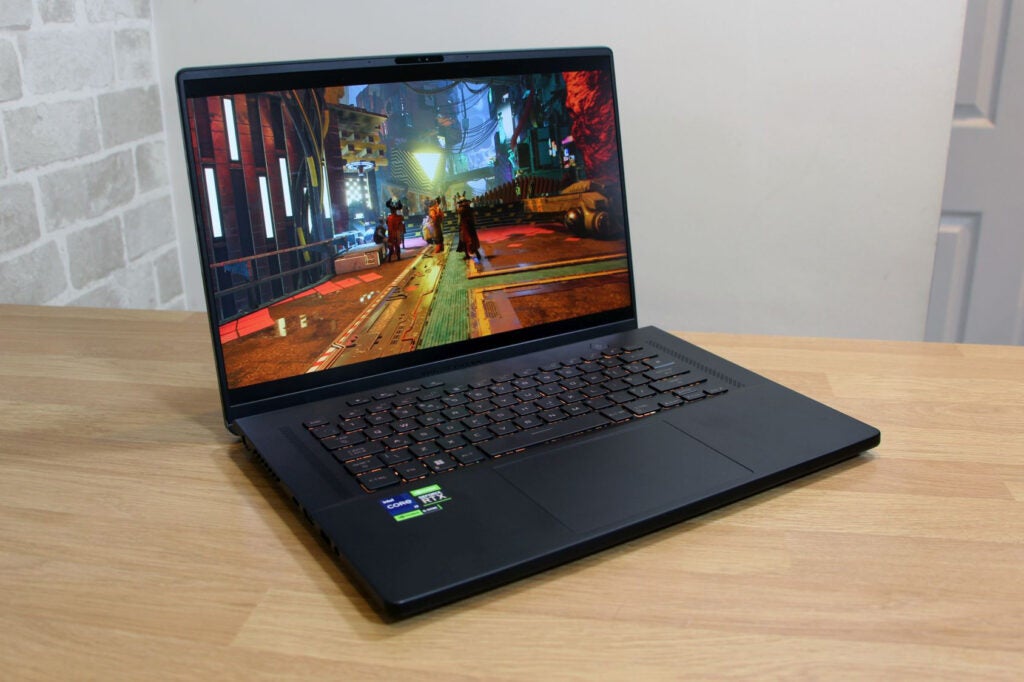
The Delta E of 3.65 is fine, and the panel renders 100% and 98.6% of the sRGB and DCI-P3 colour spaces but only 87.2% of the Adobe space, so the screen can’t quite handle tough content creation.
For mainstream content creation, media viewing and any gaming situation, though, this is the best display you’ll find on any gaming laptop.
It does remain to be seen if other laptops will outpace the M16’s panel. The Alienware will have three IPS configurations with a 480Hz option for eSports. The biggest contender will be the Razer, which will have a Mini LED panel that switches between a high-resolution 120Hz mode and a lower-resolution 240Hz option.
The audio is decent, too, thanks to pairs of 2W tweeters and woofers. The M16 has punchy bass, solid treble and plenty of high-end detail, and the speakers are good enough for any game or media situation. The top-end is a little tinny, but that’s a minor criticism.
Performance
- Nvidia RTX 4090 offers tremendous speed
- Intel’s Core i9-13900H is reliably quick
- Doesn’t make much noise, although Turbo mode is louder
The GeForce RTX 4090 is Nvidia’s latest mobile flagship, and the Ada Lovelace architecture shows up with 9728 stream processors and 16GB of memory. In this slim laptop, though, it’s got a peak power level of 145W with dynamic boosting, which is 30W short of Razer and Alienware’s rigs.
Alongside the GPU there’s an Intel Core i9-13900H, which has six Performance cores that address twelve threads with a 5.4GHz top speed, and there’s 16GB of DDR5 memory and a 1TB Samsung SSD with solid read and write speeds of 7049 MB/sec and 5152 MB/sec.
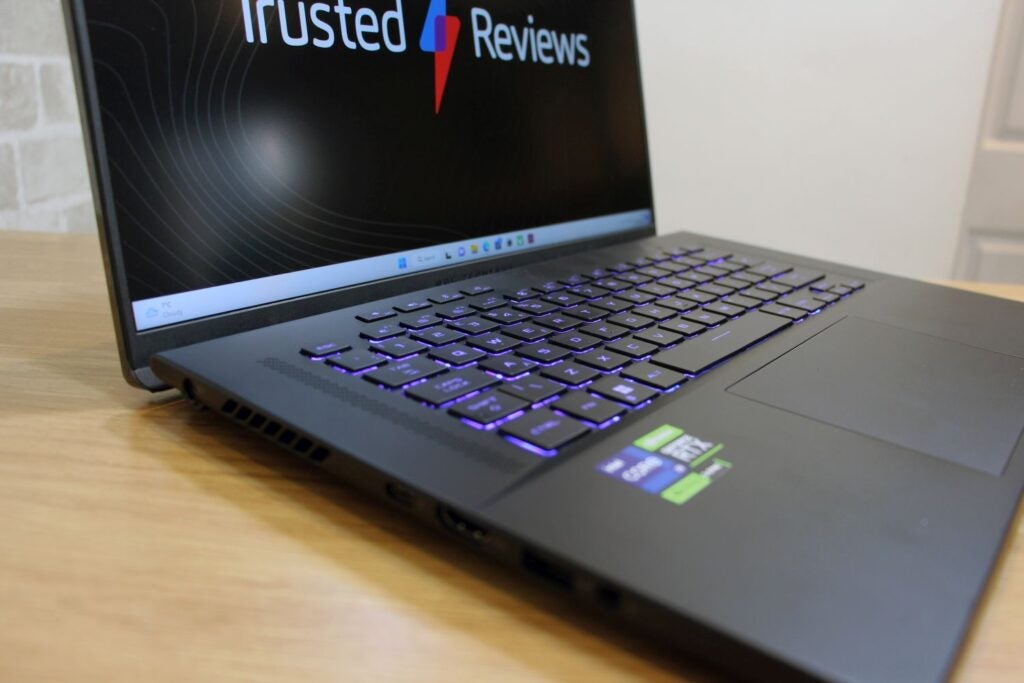
In Horizon Zero Dawn at 2560 x 1600 and Ultimate settings the M16 averaged 101fps, and it played Borderlands 3 at 73fps. A 260fps result in Rainbow Six Siege means you’ve got plenty of eSports grunt. You’ll be able to handle virtually any gaming situation on this notebook, from any single-player title with ray tracing to outputting to 4K screens and VR headsets with hardly any settings tweaks.
There’s a wrinkle in these results, though, because the M16’s default Performance mode only runs the GPU with an 85W power level, so its pace barely differs from the RTX 3080 Ti I tested in the record-breaking MSI Raider GE77.
To get the most out of the GPU, switch to Turbo mode. In this mode that 73fps Borderlands score improved to 94fps, and the Rainbow Six result soared to 297fps. The rig’s initial Time Spy result of 14,298 rose to 18,195.
Turbo mode has a thermal impact. In Performance mode the M16 you’ll notice the fan noise, but the Asus is quieter than most rigs at this level – certainly pretty manageable in everyday gaming situations. Switch to Turbo mode and it makes a racket and you’ll need a headset.
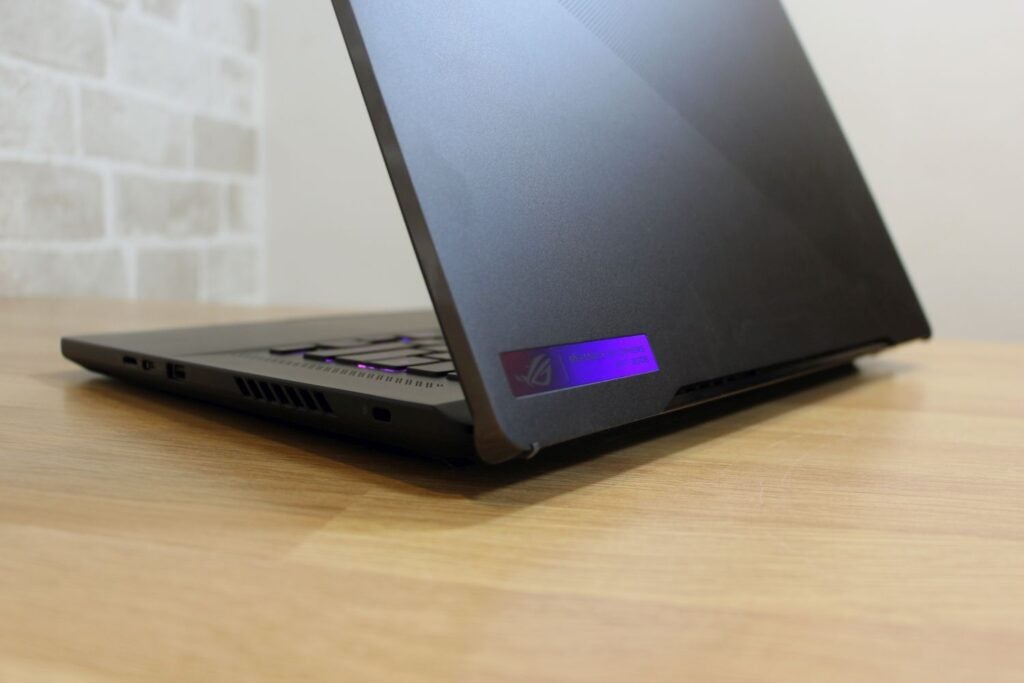
Also, remember that while the Turbo mode unleashes the full 145W might of the GPU, you’ll still get more power from the Razer and Alienware notebooks.
The Raptor Lake-based i9-13900H is excellent, with Geekbench results of 1946 and 14,459 that almost outpace the MSI’s Core i9-12900HX despite the chip rarely operating at full speed in the M16. Its Cinebench R23 result of 16,415 trounces the 12,938 score gleaned from the Core i7-12700H, which bodes well for creative workloads, and it’s far faster than the AMD chip inside the Asus ROG Flow X16.
There’s not much this chip won’t do, from editing photos and 4K videos to multitasking and running loads of browser tabs. And outside of the Turbo mode, where noise levels remained high, the M16 was quieter when processing than when gaming.
| Asus ROG Zephyrus M16 | Asus ROG Flow X16 | MSI Raider GE77 | |
| CPU | Intel Core i9-13900H | AMD Ryzen 9 6900HS | Intel Core i9-12900HX |
| PCMark10 | 8129 | 7529 | 7038 |
| Geekbench 5 Single / Multi | 1946 / 14,459 | 1556 / 10,067 | 1833 / 15,872 |
| GPU | Nvidia RTX 4090 | Nvidia RTX 3070 Ti | Nvidia RTX 3080 Ti |
| 3DMark Time Spy | 14,298 | 8,991 | 13,593 |
That’s great, but the forthcoming Razer and Alienware will be even faster thanks to Core i9-13950HX chips and other high-end options. Most people won’t need that power, but it’s worth bearing in mind.
It’s also important to consider the different models of the M16. In the UK, the RTX 4090 version is slated for release at a £4099 price and the RTX 4080 rig costs £3299, so there’s a big disparity there.
There’s more choice in the US, where RTX 4070 models will be built too. The RTX 4070 rig will have an IPS screen, and only the RTX 4090 rig will have AniMe Matrix. Asus hasn’t confirmed specific US pricing but has said its M16 models will cost between $1949 and $3499.
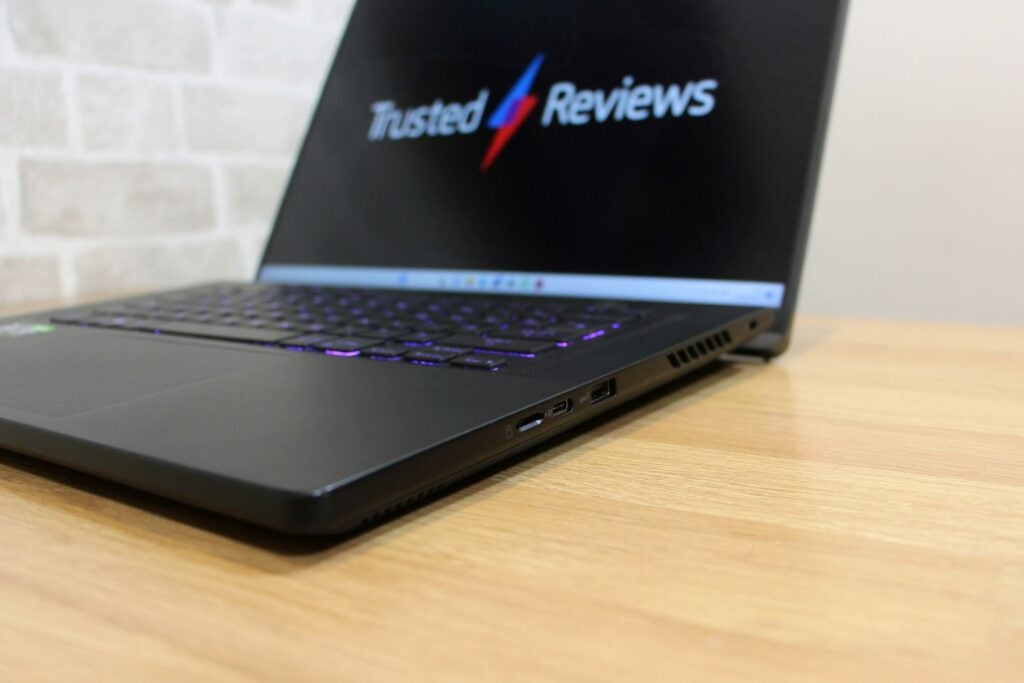
In Europe, Asus currently lists RTX 4090 and RTX 4080 models with prices at €5,099 and €4,599, but there’s no word if an RTX 4070 version will appear.
That’s a high price, but the M16 doesn’t necessarily represent bad value. If you want a Blade 16 with an RTX 4090 it’ll cost you $4299/£4399/€4999, so the M16 is cheaper in the US and the UK. The Blade also starts at $2699 in the US, so its more affordable models are pricier than the M16. Alienware’s laptops will likely be more expensive than the M16, too.
Of course, those machines will have better processors and graphics cards and advantages elsewhere, but the M16 may end up as one of the cheapest and lightest RTX 4090 laptops on the market.
Battery
- Will only last about an hour if you want to play top titles
- In work situations it’ll struggle to get through half a day
If you do shell out for the Asus ROG Zephyrus M16, don’t expect great battery life. With the screen brightness reduced, we got 1hr 25mins of gaming from the M16, but that figure dove below one hour with the brightness increased.
In a modest office test we got five hours of use from the M16, but that will drop to three or four hours if you push the hardware and ramp up brightness.
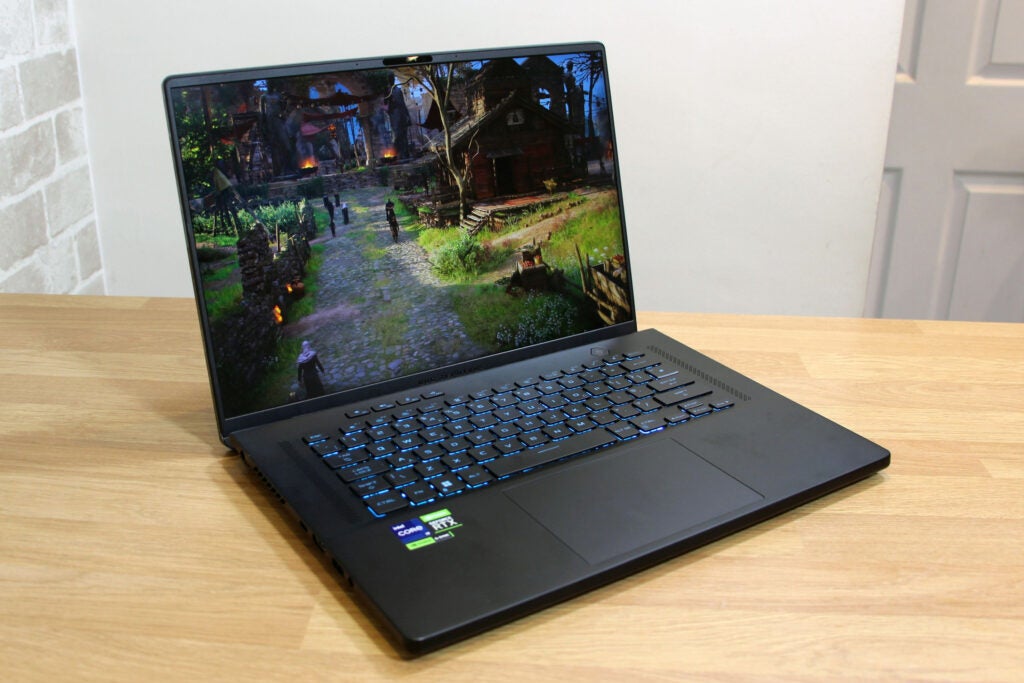
Latest deals
Should you buy it?
You want Nvidia’s latest hardware and an amazing screen in a light laptop:
The Asus isn’t quite the fastest RTX 4090 laptop, but it’s plenty fast enough – and the screen is incredible. It’s slim, light and smart-looking, too.
You’d prefer to wait for even faster rigs or need a more robust keyboard:
Forthcoming laptops from Razer and Alienware will be even faster and will probably have better ergonomics and connectivity, even at a higher price
Final Thoughts
The Asus ROG Zephyrus M16 (2023) pairs fantastic gaming and processing pace alongside one of the best screens you’ll find in any gaming laptop – and all inside a smart, light chassis. But it’s ordinary in several areas, and better laptops will likely emerge in the coming months
How we test
Every gaming laptop we review goes through a series of uniform checks designed to gauge key things including build quality, performance, screen quality and battery life.
These include formal synthetic benchmarks and scripted tests, plus a series of real world checks, such as how well it runs when running a AAA game.
We used as our main laptop for at least a week.
Tested the performance via both benchmark tests and real-world use.
We tested the screen with a colorimeter and real-world use.
We tested the battery with a benchmark test and real-world use.
FAQs
This model of the Zephyrus M16 will cost $3499/£4099/€5099.
Yes, this is a very powerful laptop for gaming.
Trusted Reviews test data
PCMark 10
Cinebench R23
Geekbench 5 single core
Geekbench 5 multi core
3DMark Time Spy
CrystalDiskMark Read speed
CrystalMarkDisk Write Speed
Brightness
Black level
Contrast
White Visual Colour Temperature
sRGB
Adobe RGB
DCI-P3
PCMark Battery (office)
PCMark Battery (gaming)
Borderlands 3 frame rate (Quad HD)
Borderlands 3 frame rate (Full HD)
Horizon Zero Dawn frame rate (Quad HD)
Horizon Zero Dawn frame rate (Full HD)
Dirt Rally (Quad HD)
Dirt Rally (Full HD)
UK RRP
USA RRP
EU RRP
CPU
Manufacturer
Screen Size
Storage Capacity
Front Camera
Battery
Battery Hours
Size (Dimensions)
Weight
Operating System
Release Date
First Reviewed Date
Model Number
Model Variants
Resolution
HDR
Refresh Rate
Ports
Audio (Power output)
GPU
RAM
Connectivity
Colours
Display Technology
Touch Screen
Convertible?
Jargon buster
Refresh Rate
The number of times the screen refreshes itself per second.
Verdict
The Asus ROG Zephyrus M16 (2023) delivers incredible speed thanks to Nvidia’s latest graphics core. And elsewhere you get a robust, light chassis and one of the best gaming laptop displays ever – but forthcoming rigs will be faster, and in several areas the M16 is too ordinary.
Pros
- Incredible gaming and processing speed
- One of the best laptop screens ever
- Fast, comfortable keyboard
- Sleek, sturdy and light chassis
Cons
- Other laptops will be even faster
- Annoying LEDs in lid
- Better connectivity and ergonomics elsewhere
- Difficult to get inside
Availability
- UKRRP: £4099
- USARRP: $3499
- EuropeRRP: €5099
-
Nvidia’s GeForce RTX 4090The new Nvidia GeForce RTX 4090 laptop graphics core is a barnstorming chip that will scythe through almost any gaming task, although in this laptop it doesn’t run at the peak of its powers. -
A fantastic Mini LED displayThe Mini LED display delivers incredible depth, contrast and nuance – it’s the best gaming laptop screen on the market right now and makes titles look their best. Elsewhere, the 240Hz refresh rate, 16:10 aspect ratio and high resolution all improve visual versatility. -
A sleek, robust chassisThe aluminium case has great build quality and a smart, subtle aesthetic – and it’s lighter than virtually any rival too, including laptops coming later this year.
Introduction
Asus usually pushes the envelope with gaming laptops, and the Asus ROG Zephyrus M16 (2023) shy away from innovation – because it crams an Nvidia GeForce RTX 4090 into a surprisingly small chassis.
That’s not the only surprise you’ll find here. It’s got one of Intel’s beefiest Core i9 processors, and the lid is filled with customisable LEDs.
The design will tempt any gamer, but it will also cost $3499/£4099/€5099. And no matter where you live, that’s a healthy chunk of change.
With the Razer Blade 16 and Alienware m16 R1 arriving soon, and existing laptops like the Asus ROG Flow X16 offering stiff competition, it might be tricky for the M16 to secure a slot on our best gaming laptops 2023 chart.
Design and Keyboard
- The aluminium enclosure is smart, light and robust
- The AniMe Matrix lid is a gimmick that adds weight
- The keyboard and trackpad are fine for everyday use
Asus hasn’t made big changes to the outside – this GU604 model looks similar to the GU603 from 2022. But when the rig uses matte aluminium alloy, black surfaces and sleek lines to craft a stylish chassis that’s not necessarily a problem.
You’ll find speaker grilles on each side of the keyboard, cooling vents below the screen and an ergo hinge that pushes the keyboard upwards to improve typing angles and internal cooling.

Build quality is impressive, with hardly any give in the panels, and the RTX 4090 version of this laptop weighs 2.3kg and is 22.9mm thick. That compares well to the Razer and Alienware laptops, which will weigh 2.45kg, although the Asus ROG Flow X16 convertible is slimmer and lighter.
The AniMe Matrix lid is the M16’s boldest design feature: it’s got 1,711 LEDs that sit behind 18,710 CNC-milled holes. They’re customisable with animations, text, a virtual pet or information like your battery life and email count. It’s a gimmick, though, and only runs in white – and the LEDs add 200g to the rig’s weight. Thankfully the AniMe Matrix is only available on the RTX 4090 model.
There are other areas where the design falters. The status lights sit beneath the screen and they’re basically impossible to see. And while the Asus has memory slots and SSD connectors for component upgrades, it’s extremely difficult to get inside – it feels like Asus has made it unnecessarily hard.

The keyboard is crisp, fast and reliable, so it’s well-suited to fast-paced gaming, but it omits the numberpad and only has single-zone RGB LED lighting. The Alienware is available with mechanical upgrades and the Razer has per-key RGB LEDs. The trackpad is mediocre, too, with soft buttons that won’t sate demanding gamers – use a USB mouse instead.
And while connectivity is fine, other laptops are better. The Asus has two USB 3.2 Gen 2 ports, a USB 3.2 Gen 2 Type-C port and one Thunderbolt connection alongside a microSD slot and HDMI 2.1 output. Internally it’s got Wi-Fi 6E, Bluetooth 5.2 and a 1080p webcam with Windows Hello support.
The Alienware and Razer rigs both have SD card readers and 2.5Gbps Ethernet, the Alienware has two Thunderbolt ports, and the Razer has three full-size USB connectors.
Screen
- Incredible contrast, depth, detail and vibrancy on the Mini LED screen
- The 240Hz refresh rate and solid resolution deliver absorbing visuals
- The speakers are good, too
The AniMe Matrix may be silly, but the actual display on the Asus ROG Zephyrus M16 is one of the best laptop screens ever. It’s a Mini LED panel with a 2560 x 1600 resolution, 16:10 aspect ratio and 240Hz refresh rate with G-Sync, and it’s got 1024 dimming zones, a quoted brightness level of 1200 nits and a 3ms response time.
That’s fearsome. The Mini LED hardware and the number of zones means you’ll get more depth and contrast than any IPS screen, the resolution and aspect ratio deliver solid sharpness and height, and the 240Hz refresh rate will sate anyone except top eSports players.
The benchmarks bolster the M16. In SDR mode the peak brightness of 618 nits is huge, the black level of 0.027 nits is tiny, and the contrast ratio of 22,888:1 is fantastic – you get eye-searing depth and punch that’s only barely beaten by OLED hardware. The panel also hits its higher brightness level in HDR mode, so HDR games have sensational depth.

The Delta E of 3.65 is fine, and the panel renders 100% and 98.6% of the sRGB and DCI-P3 colour spaces but only 87.2% of the Adobe space, so the screen can’t quite handle tough content creation.
For mainstream content creation, media viewing and any gaming situation, though, this is the best display you’ll find on any gaming laptop.
It does remain to be seen if other laptops will outpace the M16’s panel. The Alienware will have three IPS configurations with a 480Hz option for eSports. The biggest contender will be the Razer, which will have a Mini LED panel that switches between a high-resolution 120Hz mode and a lower-resolution 240Hz option.
The audio is decent, too, thanks to pairs of 2W tweeters and woofers. The M16 has punchy bass, solid treble and plenty of high-end detail, and the speakers are good enough for any game or media situation. The top-end is a little tinny, but that’s a minor criticism.
Performance
- Nvidia RTX 4090 offers tremendous speed
- Intel’s Core i9-13900H is reliably quick
- Doesn’t make much noise, although Turbo mode is louder
The GeForce RTX 4090 is Nvidia’s latest mobile flagship, and the Ada Lovelace architecture shows up with 9728 stream processors and 16GB of memory. In this slim laptop, though, it’s got a peak power level of 145W with dynamic boosting, which is 30W short of Razer and Alienware’s rigs.
Alongside the GPU there’s an Intel Core i9-13900H, which has six Performance cores that address twelve threads with a 5.4GHz top speed, and there’s 16GB of DDR5 memory and a 1TB Samsung SSD with solid read and write speeds of 7049 MB/sec and 5152 MB/sec.

In Horizon Zero Dawn at 2560 x 1600 and Ultimate settings the M16 averaged 101fps, and it played Borderlands 3 at 73fps. A 260fps result in Rainbow Six Siege means you’ve got plenty of eSports grunt. You’ll be able to handle virtually any gaming situation on this notebook, from any single-player title with ray tracing to outputting to 4K screens and VR headsets with hardly any settings tweaks.
There’s a wrinkle in these results, though, because the M16’s default Performance mode only runs the GPU with an 85W power level, so its pace barely differs from the RTX 3080 Ti I tested in the record-breaking MSI Raider GE77.
To get the most out of the GPU, switch to Turbo mode. In this mode that 73fps Borderlands score improved to 94fps, and the Rainbow Six result soared to 297fps. The rig’s initial Time Spy result of 14,298 rose to 18,195.
Turbo mode has a thermal impact. In Performance mode the M16 you’ll notice the fan noise, but the Asus is quieter than most rigs at this level – certainly pretty manageable in everyday gaming situations. Switch to Turbo mode and it makes a racket and you’ll need a headset.

Also, remember that while the Turbo mode unleashes the full 145W might of the GPU, you’ll still get more power from the Razer and Alienware notebooks.
The Raptor Lake-based i9-13900H is excellent, with Geekbench results of 1946 and 14,459 that almost outpace the MSI’s Core i9-12900HX despite the chip rarely operating at full speed in the M16. Its Cinebench R23 result of 16,415 trounces the 12,938 score gleaned from the Core i7-12700H, which bodes well for creative workloads, and it’s far faster than the AMD chip inside the Asus ROG Flow X16.
There’s not much this chip won’t do, from editing photos and 4K videos to multitasking and running loads of browser tabs. And outside of the Turbo mode, where noise levels remained high, the M16 was quieter when processing than when gaming.
| Asus ROG Zephyrus M16 | Asus ROG Flow X16 | MSI Raider GE77 | |
| CPU | Intel Core i9-13900H | AMD Ryzen 9 6900HS | Intel Core i9-12900HX |
| PCMark10 | 8129 | 7529 | 7038 |
| Geekbench 5 Single / Multi | 1946 / 14,459 | 1556 / 10,067 | 1833 / 15,872 |
| GPU | Nvidia RTX 4090 | Nvidia RTX 3070 Ti | Nvidia RTX 3080 Ti |
| 3DMark Time Spy | 14,298 | 8,991 | 13,593 |
That’s great, but the forthcoming Razer and Alienware will be even faster thanks to Core i9-13950HX chips and other high-end options. Most people won’t need that power, but it’s worth bearing in mind.
It’s also important to consider the different models of the M16. In the UK, the RTX 4090 version is slated for release at a £4099 price and the RTX 4080 rig costs £3299, so there’s a big disparity there.
There’s more choice in the US, where RTX 4070 models will be built too. The RTX 4070 rig will have an IPS screen, and only the RTX 4090 rig will have AniMe Matrix. Asus hasn’t confirmed specific US pricing but has said its M16 models will cost between $1949 and $3499.

In Europe, Asus currently lists RTX 4090 and RTX 4080 models with prices at €5,099 and €4,599, but there’s no word if an RTX 4070 version will appear.
That’s a high price, but the M16 doesn’t necessarily represent bad value. If you want a Blade 16 with an RTX 4090 it’ll cost you $4299/£4399/€4999, so the M16 is cheaper in the US and the UK. The Blade also starts at $2699 in the US, so its more affordable models are pricier than the M16. Alienware’s laptops will likely be more expensive than the M16, too.
Of course, those machines will have better processors and graphics cards and advantages elsewhere, but the M16 may end up as one of the cheapest and lightest RTX 4090 laptops on the market.
Battery
- Will only last about an hour if you want to play top titles
- In work situations it’ll struggle to get through half a day
If you do shell out for the Asus ROG Zephyrus M16, don’t expect great battery life. With the screen brightness reduced, we got 1hr 25mins of gaming from the M16, but that figure dove below one hour with the brightness increased.
In a modest office test we got five hours of use from the M16, but that will drop to three or four hours if you push the hardware and ramp up brightness.

Latest deals
Should you buy it?
You want Nvidia’s latest hardware and an amazing screen in a light laptop:
The Asus isn’t quite the fastest RTX 4090 laptop, but it’s plenty fast enough – and the screen is incredible. It’s slim, light and smart-looking, too.
You’d prefer to wait for even faster rigs or need a more robust keyboard:
Forthcoming laptops from Razer and Alienware will be even faster and will probably have better ergonomics and connectivity, even at a higher price
Final Thoughts
The Asus ROG Zephyrus M16 (2023) pairs fantastic gaming and processing pace alongside one of the best screens you’ll find in any gaming laptop – and all inside a smart, light chassis. But it’s ordinary in several areas, and better laptops will likely emerge in the coming months
How we test
Every gaming laptop we review goes through a series of uniform checks designed to gauge key things including build quality, performance, screen quality and battery life.
These include formal synthetic benchmarks and scripted tests, plus a series of real world checks, such as how well it runs when running a AAA game.
We used as our main laptop for at least a week.
Tested the performance via both benchmark tests and real-world use.
We tested the screen with a colorimeter and real-world use.
We tested the battery with a benchmark test and real-world use.
FAQs
This model of the Zephyrus M16 will cost $3499/£4099/€5099.
Yes, this is a very powerful laptop for gaming.
Trusted Reviews test data
PCMark 10
Cinebench R23
Geekbench 5 single core
Geekbench 5 multi core
3DMark Time Spy
CrystalDiskMark Read speed
CrystalMarkDisk Write Speed
Brightness
Black level
Contrast
White Visual Colour Temperature
sRGB
Adobe RGB
DCI-P3
PCMark Battery (office)
PCMark Battery (gaming)
Borderlands 3 frame rate (Quad HD)
Borderlands 3 frame rate (Full HD)
Horizon Zero Dawn frame rate (Quad HD)
Horizon Zero Dawn frame rate (Full HD)
Dirt Rally (Quad HD)
Dirt Rally (Full HD)
UK RRP
USA RRP
EU RRP
CPU
Manufacturer
Screen Size
Storage Capacity
Front Camera
Battery
Battery Hours
Size (Dimensions)
Weight
Operating System
Release Date
First Reviewed Date
Model Number
Model Variants
Resolution
HDR
Refresh Rate
Ports
Audio (Power output)
GPU
RAM
Connectivity
Colours
Display Technology
Touch Screen
Convertible?
Jargon buster
Refresh Rate
The number of times the screen refreshes itself per second.

























